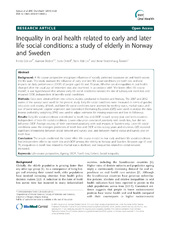| dc.contributor.author | Gülcan, Ferda | en_US |
| dc.contributor.author | Ekbäck, Gunnar | en_US |
| dc.contributor.author | Ordell, Sven | en_US |
| dc.contributor.author | Lie, Stein Atle | en_US |
| dc.contributor.author | Åstrøm, Anne Nordrehaug | en_US |
| dc.date.accessioned | 2015-12-11T12:18:24Z | |
| dc.date.available | 2015-12-11T12:18:24Z | |
| dc.date.issued | 2015-02-10 | |
| dc.Published | BMC Oral Health 2015, 15:20 | eng |
| dc.identifier.issn | 1472-6831 | |
| dc.identifier.uri | https://hdl.handle.net/1956/10749 | |
| dc.description.abstract | Background A life course perspective recognizes influences of socially patterned exposures on oral health across the life span. This study assessed the influence of early and later life social conditions on tooth loss and oral impacts on daily performances (OIDP) of people aged 65 and 70 years. Whether social inequalities in oral health changed after the usual age of retirement was also examined. In accordance with “the latent effect life course model”, it was hypothesized that adverse early-life social conditions increase the risk of subsequent tooth loss and impaired OIDP, independent of later-life social conditions. Methods Data were obtained from two cohorts studies conducted in Sweden and Norway. The 2007 and 2012 waves of the surveys were used for the present study. Early-life social conditions were measured in terms of gender, education and country of birth, and later-life social conditions were assessed by working status, marital status and size of social network. Logistic regression and Generalized Estimating Equations (GEE) were used to analyse the data. Inverse probability weighting (IPW) was used to adjust estimates for missing responses and loss to follow-up. Results Early-life social conditions contributed to tooth loss and OIDP in each survey year and both countries independent of later-life social conditions. Lower education correlated positively with tooth loss, but did not influence OIDP. Foreign country of birth correlated positively with oral impacts in Sweden only. Later-life social conditions were the strongest predictors of tooth loss and OIDP across survey years and countries. GEE revealed significant interactions between social network and survey year, and between marital status and survey year on tooth loss. Conclusion The results confirmed the latent effect life course model in that early and later life social conditions had independent effects on tooth loss and OIDP among the elderly in Norway and Sweden. Between age 65 and 70, inequalities in tooth loss related to marital status declined, and inequalities related to social network increased. | en_US |
| dc.language.iso | eng | eng |
| dc.publisher | BioMed Central | eng |
| dc.relation.ispartof | <a href="http://hdl.handle.net/1956/15596" target="_blank">Oral health-related quality of life, tooth loss and utilization of dental services among older people in Norway and Sweden. A prospective and comparative perspective</a> | |
| dc.rights | Attribution CC BY | eng |
| dc.rights.uri | http://creativecommons.org/licenses/by/4.0 | eng |
| dc.subject | Life-course perspective | eng |
| dc.subject | OIDP | eng |
| dc.subject | Social inequality | eng |
| dc.title | Inequality in oral health related to early and later life social conditions: A study of elderly in Norway and Sweden | en_US |
| dc.type | Peer reviewed | |
| dc.type | Journal article | |
| dc.date.updated | 2015-11-05T13:36:22Z | |
| dc.description.version | publishedVersion | en_US |
| dc.rights.holder | Copyright Gülcan et al.; licensee BioMed Central. 2015 | |
| dc.identifier.doi | https://doi.org/10.1186/s12903-015-0005-y | |
| dc.identifier.cristin | 1242136 | |
| dc.subject.nsi | VDP::Medisinske fag: 700::Helsefag: 800::Samfunnsodontologi: 802 | |
| dc.subject.nsi | VDP::Midical sciences: 700::Health sciences: 800::Community dentistry: 802 | |
| dc.subject.nsi | VDP::Medisinske Fag: 700 | en_US |

